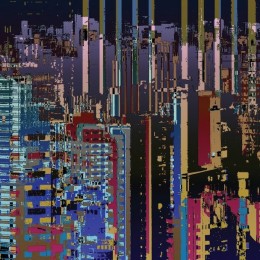According to many of his friends, the most striking talent of former president George H.W. Bush is for the accumulation of names on the world’s best Rolodex. For all his manipulations of space and sonics, ear for the gauche and the sublime, and fondness for the grand gesture as much as for the quiet, sustained synth block chord, Brian Eno accepts projects like the scion he is: he may turn a modest profit, and it might be fun. Collaborations with the likes of Coldplay and U2 sent Eno, as if to a ritual purging, back to his erstwhile partner David Byrne. The result, Everything That Happens Will Happen To Me, was the most beguiling album for both of them since, of course, the first Bush administration.
On his latest Eno works with self-described poet Richard Holland, who presumably worked on the lyrics while His Eggheadedness attended to the task of generating atmospheres for them – or fogs. Although Drums Between The Bells is Eno’s second album for Warp Records, presumably to give it the imprimatur of a dance project, its devotion to skittering, volatile surfaces won’t fool anyone looking for mirrorball kinetics, not to mention any fan who’s watched with dismay as Eno’s career since 1992’s Neroli concentrates – I use the verb loosely – on whirring banality. His trick here is to build the tracks around a phalanx of interchangeable female vocalists, often stretching their vowels or consonants via electronic means. The effect is at times soothing: ‘The Real’ sounds like an updated sonic relative of a Big Science-era Laurie Anderson track. In other moments, such as the nervous pulsings of the single ‘Glitch’ (now there’s truth in advertising!), Eno remembers how atonality and inspired juxtaposition were once good friends of his. This truism also applies to ‘Seedpods’, which is the aural equivalent of several metal lids whirling beside a microphone. The aptly named ‘Sounds Alien’, constructed around a no-doubt programmed drum pattern, atonal horn blasts, and shriekback guitar, would be too busy for its own good on other Eno records but is right at home here.
But the combination of Eno’s obsession with stasis and his attachment to novelty for its own sake does the album in (its real title should be Bells Between The Bells). This is an album which actually includes fifty-eight seconds of silence called ‘Silence’, as if he thought John Lennon’s 1973 ‘Nutopian International Anthem’ remained an avant-garde totem. As for the featured collaborator, Holland doesn’t write poetry so much as end-time nostrums collected in expensive private editions. His sensibility, such as it is, comes closest to meshing with Eno’s on the organ-anchored ‘Cloud 4’, a pastoral as lovely as Another Day on Earth‘s ‘How Many Worlds’. In sum, Drums Between the Bells works best as another card in the scion’s Rolodex.


